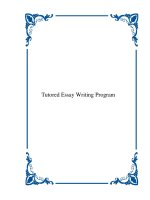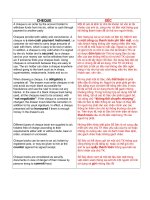Tài liệu Student book answer key pdf
Bạn đang xem bản rút gọn của tài liệu. Xem và tải ngay bản đầy đủ của tài liệu tại đây (256.43 KB, 31 trang )
54 Answer Key
1
A3: After You Read (p. 3)
1.
2.
Examining Form (p. 3)
A.
1.
s/-es
ing
d/-ed
ing
2.
don’t/doesn’t do/does
beamisare
havehavehas
have
havehasbeen
B.
Examining Meaning and Use (p. 4)
1. 3.
2. 4.
B1: Listening (p. 7)
A.
B. 4.
2. 5.
3. 6.
B2: Contrasting Verb Forms (p. 7)
Simple Present vs. Present Continuous
1. 4.
2. 5.
3.
Simple Present vs. Present Perfect
6. 8.
7. 9.
Present Perfect vs. Present Perfect Continuous
10. 12.
11. 13.
B3: Comparing Simple and Continuous Meanings (p. 8)
A. 1. 4.
2. 5.
3. 6.
B.
B4: Background Information and Present
Situations (p. 8)
2.
3.
4.
5.
6.
7.
B5: Talking About Accomplishments and Progress (p. 9)
B6: Using Forms in Combination (p. 9)
B7: Thinking About Meaning and Use (p. 10)
1. 4. 7. 10.
2. 5. 8.
3. 6. 9.
continue
have
are studying
have made
has been growing
have added
Answer Key 55
B8: Speaking (p. 10)
C1: Editing (p. 11)
1.
2.
3.
4.
5.
6.
C2: Recognizing Present Contexts (p. 12)
A. 3
X
X / 3
3
X
X
3
B.
C3: Talking About Your Life (p. 13)
C4: Writing Tip (p. 13)
2
A3: After You Read (p. 17)
1.
2.
3.
Examining Form (p. 17)
A.
-d/-ed
ing
-d/-ed
ing
2.
didn’tdid
bewaswere
Had
Had been
B.
Examining Meaning and Use (p. 18)
1. 3.
2. 4.
B1: Listening (p. 20)
A.
B. 1. 4.
2. 5.
3. 6.
B2: Contrasting Verb Forms (p. 20)
Simple Past vs. Past Continuous
1.
2.
3
4.
5.
Simple Past vs. Present Perfect
6.
7.
8.
9.
B3: Simple Past vs. Present Perfect (p. 21)
2.
3.
4.
5.
6.
tend
are
have have
has
always
have
has opened
visited
was looking
haven't learned
had
was
was paying
56 Answer Key
B4: Using Time Clauses (p. 22)
1.
2.
3.
4.
B5: Describing a Past Event (p. 22)
Examining Meaning and Use (p. 23)
1.
2.
3.
C1: Listening (p. 25)
A. 1. 3.
2.
B. 1. 3.
2.
C2: Contrasting Verb Forms (p. 25)
1.
2.
3.
4.
5.
6.
7.
8.
C3: Giving Background Information (p. 26)
C4: Combining Verb Tenses (p. 27)
A.
2.
3.
4.
5.
6.
B.
C5: Thinking About Meaning and Use (p. 28)
1.
2.
3.
C6: Speaking (p. 28)
D1: Editing (p. 29)
1.
2.
3.
4.
5.
6.
7.
8.
D2: Recognizing Shifts in Time (p. 31)
2.
3.
D3: Practicing Shifts in Time (p. 31)
2.
3.
4.
5.
6.
D4: Writing Tip (p. 32)
3
A3: After You Read (p. 35)
1.
2.
2
1
2
1
1
2
1
2
2
1
1
2
, it
was blowing
did
were
leading
until
immediatley
announce
had
didn't
not
Answer Key 57
3.
Examining Form (p. 36)
A.
Be going to
ing
ing
s/-es
d/-ed
ing
2. Will
Be going tobeam, is,
aregoing to
Will be
be
am, is, are
Will have
Will have been
3.
will
B.
Examining Meaning and Use (p. 36)
1. 3.
B1: Listening (p. 39)
A.
B. 1. 4.
2. 5.
3. 6.
B2: Contrasting Verb Forms (p. 40)
A. 1.
2.
3.
4.
5.
6.
7.
8.
9.
12.
B.
B3: Contrasting Simple and Continuous Future
Forms (p. 41)
1. 5.
2. 6.
3. 7.
4. 8.
B4: Talking About a Sequences of Events in the
Future (p. 42)
A.
2.
3.
4.
5.
B.
B5: Making Plans with Be Going To and Will (p. 43)
B6: Making Predictions with Be Going To, Will, and
the Future Continuous (p. 44)
B7: Talking About Future Goals with the Future
Perfect (p. 44)
B8: Speaking (p. 45)
will make
are meeting
will be collecting
will have become
will have disappeared,
Is the
will tell
going to affect
58 Answer Key
B9: Thinking About Meaning and Use (p. 45)
1. 5.
2. 6.
3. 7.
4. 8.
C1: Editing (p. 47)
C2: Recognizing Shifts in Time (p. 48)
A. 1.
2. 6.
B.
C3: Talking About Plans (p. 49)
A. 2. 6.
3. 5.
B.
C4: Writing Tip (p. 49)
4
A3: After You Read (p. 53)
1.
2.
3.
Examining Form (p. 53)
A.
1.
2.
ing
3.
Be
Have
B.
Examining Meaning and Use (p. 54)
1. 3.
2. 4.
B1: Listening (p. 57)
A.
B. 1. 4.
2. 5.
3. 6.
B2: Contrasting Modal Forms (p. 57)
1. 8.
2. 9.
3. 10.
4. 11.
5. 12.
6. 13.
7. 14.
B3: Choosing Modals or Phrasal Modals (p. 58)
2.
3.
4.
5.
6.
7.
must be
could
had to be
were not supposed to use
could learn
could
have lasted
Shouldn't interest
have faded
unless
is
not
are
is
have
Answer Key 59
8.
9.
10.
B4: Discussing Rules and Requirements (p. 59)
A. 1. 6.
2. 7.
3. 8.
4. 9.
5. 10.
B.
B5: Giving Past, Present, and Future Advice (p. 60)
B6: Making Statements with Modals (p. 61)
Examining Meaning and Use (p. 62)
C1: Listening (p. 64)
1. 3. 5.
2. 4. 6.
C2: Restating Sentences with Modals of
Possibility (p. 64)
Present / Future Modals of Possibility
2.
3.
4.
5.
Past Modals of Possibility
6.
7.
8.
9.
10.
C3: Expressing Possibility About the Present (p. 65)
A.
2.
3.
4.
5.
B.
C4: Expressing Possibility and Certainty About the
Future (p. 65)
C5: Expressing Possibility About the Past (p. 66)
C6: Thinking About Meaning and Use (p. 67)
1. 5.
2. 6.
3. 7.
4. 8.
C7: Speaking (p. 67)
D1: Editing (p. 68)
D2: Reacting to Situations (p. 70)
A. Situation 1 Situation 2
1. 1.
2. 2.
3. 3.
B.
1.
have
resent
to
may be
shouldn't
are
talk
60 Answer Key
2.
3.
4.
D3: Working with Adverbs (p. 71)
D4: Writing Tip (p. 71)
5
A3: After You Read (p. 75)
1.
2.
3.
4.
Examining Form (p. 53)
A.
1.
2.
3. be
B.
Examining Meaning and Use (p. 75)
1. 3.
2. 4.
B1: Listening (p. 78)
A. 1. 4.
2. 5.
3. 6.
B. 1. 4.
2. 5.
3. 6.
B2: Recognizing Passive Sentences (p. 79)
1. 6.
2. 3 7. 3
3. 3 8. 3
4. 9.
5. 3 10. 3
B3: Choosing Active or Passive Verb Forms (p. 79)
1. 6.
2. 7.
3. 8.
4. 9.
5. 10.
B4: Writing Active and Passive Sentences (p. 80)
2.
3.
4.
5.
6.
B5: Changing Sentences from Active to Passive (p. 81)
2.
3.
4.
5.
6.
7.
Answer Key 61
8.
9.
10.
11.
12.
13.
14.
15.
B6: Omitting or Including Agents (p. 81)
1.
2.
3.
4.
B7: Describing Processes (p. 82)
A. 1.
2.
3.
4.
5.
6.
7.
8.
9.
10.
B.
B8: Introducing Information Objectively (p. 83)
A. 2.
3.
4.
5.
6.
B.
B9: Thinking About Meaning and Use (p. 84)
1. 4.
2. 5.
3. 6.
B10: Speaking (p. 84)
C1: Editing (p. 85)
2.
3.
4.
5.
6.
7.
C2: Keeping the Focus (p. 86)
A. 1.
2.
B. 1.
2.
C3: Organizing Information (p. 87)
2.
3.
4.
5.
C4: Writing Tip (p. 87)
6
A3: After You Read (p. 91)
1.
2.
3.
being
not have been
are
given
offered
Has
collecting
62 Answer Key
Examining Form (p. 91)
A.
B. 1.
2.
3.
Examining Meaning and Use (p. 92)
1.
2.
3.
B1: Listening (p. 95)
A.
B. 1. 4.
2. 5.
3. 6.
B2: Contrasting Nouns (p. 96)
1. 8.
2. 9.
3. 10.
4. 11.
5. 12.
6. 13.
7. 14.
B3: Using Different Types of Nouns (p. 96)
1. 7. The National Review
2. 8.
3. 9.
4. 10.
5. 11.
6.
12.
B4: Identifying Count and Noncount Nouns (p. 97)
A. 1. 9.
2. 10.
3. 11.
4. 12.
5. 13.
6. 14.
7. 15.
8.
B. 1. 4.
2. 5.
3.
C.
B5: Using Expressions with Of (p. 98)
A.
B. 2. 5.
3. 6.
4. 7.
B6: Subject-Verb Agreement with Nouns (p. 98)
1.
2.
3.
Examining Meaning and Use (p. 99)
1. 3.
2. 4.
C1: Listening (p. 101)
A.
B. 1. 4.
2. 5.
3. 6.
C2: Using Adjective and Noun Modifiers (p. 102)
1.
2.
3.
4.
5.
6.
7.
C3: Working on Compound Modifiers (p. 103)
A. 1.
2.
3.
4.
5.
6.
7.
8.
9.
10.
11.
12.
B.
C4: Recognizing Adjectives vs. Compound Modifiers
(p. 103)
3. The
Sea Inside.
4.
5.
6.
7.
rest
information
chance
years
business pleasure
a business
a chance
, and
-
-
air quality
of
office buildings
low cost
widely available houseplants
indoor
toxic chemicals
they also
with
Answer Key 63
8.
10.
11.
12.
C5: Using Compound Nouns (p. 104)
A. 2. 6.
3. 7.
4. 8.
5.
B. 2. 7.
3. 8.
4. 9.
5. 10.
6.
C.
C6: Using Prepositional Phrases (p. 105)
A. 2.
3.
4.
B. 1.
4.
8.
C.
C7: Using Modifiers Effectively (p. 105)
1.
2.
3.
4.
5.
C8: Working on Pronoun Agreement (p. 106)
1.
2.
3.
C9: Thinking About Meaning and Use (p. 106)
1. 4.
2. 5.
3. 6.
C10: Speaking (p. 107)
D1: Editing (p. 108)
D2: Using Pronouns (p. 109)
2.
3.
4.
D3: Writing Tip (p. 110)
7
A3: After You Read (p. 113)
1.
2.
3.
4.
,
, and
and
-
has year
has
air
is
information
are
64 Answer Key
Examining Form (p. 114)
A.
B. a/anthe
the
Examining Meaning and Use (p. 114)
1. 3.
2. 4.
B1: Listening (p. 117)
A.
B. 1. 4.
2. 5.
3. 6.
B2: Using A/An and The (p. 117)
1. 6.
2. 7.
3. 8.
4. 9.
5. 10.
B3: Reasons For Using Specific Nouns (p. 118)
A 1.
2.
3.
4.
5.
B.
B4: Using Articles in Newspapers (p. 118)
A.
2.
3.
4.
B. 1. 8. 15.
2. 9. 16.
3. 10. 17.
4. 11. 18.
5. 12. 19.
6. 13. 20.
7. 14. 21.
B5: Contrasting Articles (p. 119)
A. 1. 7.
2. 8.
3. 9.
4. 10.
5. 11.
6. 12.
B.
Examining Meaning an Use (p. 120)
1.
2.
3.
C1: Listening (p. 121)
1. 4.
2. 5.
3. 6.
C2: Using Possessive Adjectives to Identify Specific
Nouns (p. 122)
C3: Using Demonstrative Adjectives to Identify
Specific Nouns (p. 123)
A. 1. 5.
2. 6.
3. 7.
4. 8.
B. 1.
the
a
a
a
the
their
The subsidies
A recent
the
the
Answer Key 65
2.
C4: Working with Generic Nouns (p. 124)
C5: Connecting Information in a Paragraph (p. 125)
A. 5.
2.
7.
4.
3.
1.
8.
6.
B. 5
4
6
3
8
C6: Thinking About Meaning and Use (p. 126)
1. 4.
2. 5.
3. 6.
C7: Speaking (p. 126)
D1: Editing (p. 127)
The Global
Wanderer’s Guide to Egypt
D2: Using Articles and Pronouns (p. 128)
A. 2.
3.
4.
B.
D3: Writing Tip (p. 129)
8
A3: After You Read (p. 133)
1.
a
the
the
the
a
The
their
your









